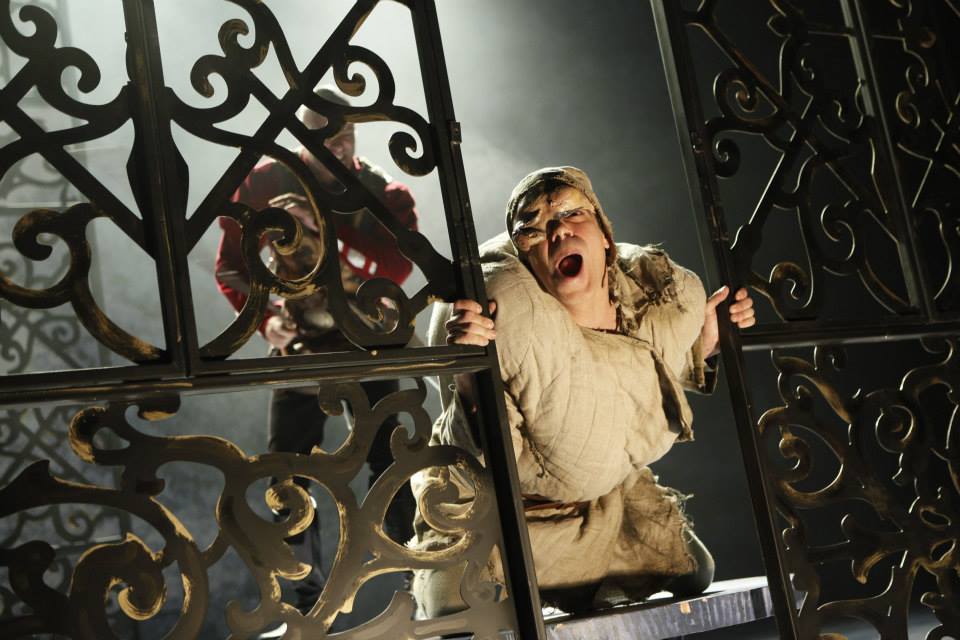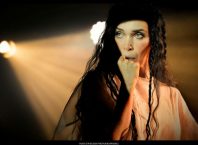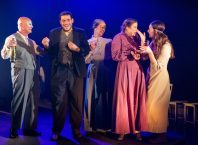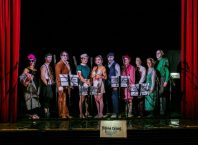A passionate tale unfolds on the stage in Ido Ricklin’s version of Victor Hugo’s gothic masterpiece The Hunchback of Notre Dame. The novel placed an almost equal weight on these two elements, Quasimodo and Notre Dame, with the cathedral playing an important symbolic and functional role. Here too, although there is no attempt to create any realistic representation of Notre Dame onstage, its symbolism is deeply felt.

Notre Dame has a multifaceted presence in the play, it not only represents the church as a place of belief and worship, but the church as a place of power, a means of governance, with its own hierarchy and wealth. Another, and not unrelated aspect of the cathedral, is its beauty, a significant theme within this play, whose hero (or anti-hero) is a hunchback, and its role as a place of sanctuary. Marking a distinction between inside and outside, Notre Dame is a place of refuge, this is where Quasimodo was taken in as a foundling infant, saved from certain death. The priest Dom Claude Frollo (Amir Krief) tells Quasimodo: “Notre Dame is your whole world.” As long as Quasimodo remains within these walls, he is safe. Safe from what? Or from whom? Is the danger outside, in the cruelty of staring strangers, or perhaps the danger was always there, within, deep in the heart and its unruly desires.
The play, as the novel, is very much about appearances and the tension between inside and outside, expressed in dramatic and visual ways, with a central organizing metaphor: the same person or object designates different characters or functions at different times, suggesting both the similarity between two opposing characters such as the leader of the gypsies and the King of France, and the difference that might be found in any person, the split and conflict within the self. The set design by Talia Ottolenghi is eloquently simple, with two key elements: a round platform that evokes the sense of an ancient place of sacrifice and performs several functions within the play, likewise two rows of sliding panels with a cut-out design resembling ironwork, acting as a divider and also as a window, an opening between realms.
Most significant is the portrayal of different characters by the same actor, most of the actors in the play take on several roles to great effect, a question not so much of economy as intention. The cheerful yet common Paquette, so easily charmed by the priest’s ne’er do well brother Jehan Frollo (Ori Mazaki), is played by the same actor, Tamar Levin, who plays the role of Fleur-de-Lys, the cosseted, corseted daughter of nobility and wealth, affianced to the handsome soldier Phoebus de Châteaupers (Gal Amitai), whose sins are perhaps better hidden, yet no less offensive. Amir Krief effects mercury-like transformations from the devout and chaste priest Dom Claude Frollo, to Clopin Trouillefou, bedraggled leader of the gypsies, and Louis XI, the dandy King of France. Lives are in the balance, and it is upon the word (or whim) of these men that fates are decided, perhaps the three are not so different from one another after all. Krief is saintly in a horrifying sort of way as Frollo, saving the infant Quasimodo from death, bathed in light as he preaches: “I find more bitter than death the woman…” (Ecclesiastes 7:26). Protecting Quasimodo from the cruelties of the world as he claims God has protected the hunchback from the sins of the flesh by giving him this broken body, paying the debts of his profligate brother Jehan, Frollo, the man of the cloth, preaches restraint, yet burns with the fires of obsession. Where Frollo is tightly held in, Clopin lets it all hang out, and his rough and ragged rule of the gypsy troupe is a delight.
Yet the most dramatic connection made here is between Quasimodo, the half-blind hunchback left for dead on the steps of the cathedral, ward of the church, tender of the bells who has become deaf through this service, and the poet Pierre Gringoire. Alon Ophir performs this dual role with poignant magnificence. In this play of appearances, Ricklin wisely has Ophir make the transformation onstage, in full view of the audience. Ophir’s very physical embodiment of Quasimodo is astonishing in its verisimilitude, he is Quasimodo. On the surface, no one could be more different from Quasimodo than the elegant (and somewhat effete) wordsmith, Gringoire. Quasimodo has difficulty understanding others, and has a hard time making himself understood, while Gringoire is a communicator by profession. They both love and are spurned by the same woman, the enchanting Esmeralda. Like the gypsy dancer Esmeralda, each of these men is, in his own way, an outsider, and to be outside is to be in danger.
Ricklin’s play makes the latent sexuality of Hugo’s novel more explicit, in a way that is not at all vulgar, yet corresponds to the more open attitudes of contemporary audiences. The theme of duality is further expressed through sexuality as both a serious and comic element within the play, providing moments of humor as well as the dark urges from whence emerge lethal outcomes. Much of the humor is visual, as expressed in the costumes designed by Svetlana Breger. Ziv Zohar Meir as La Falourdel, is exceptionally well endowed with impressive physical proportions as well as coarse wit. Codpieces, quite historically apt, are well utilized here, and the male cast are all excellently equipped. In a society with rigid social order and restrictions, seeking to control and repress, that which is intended to be concealed is accentuated and accumulates what is perhaps inevitably destined to become a destructive force.
The Hunchback of Notre Dame
Written and directed by Ido Ricklin after the novel by Victor Hugo; Set designer: Talia Ottolenghi; Costume designer: Svetlana Breger; Lighting designer: Adi Shimrony; Composer: Dori Parnes; Orchestration & Recording: Amit Poznansky; Choreography: Iris Lana; Fight coordinator: Dimitry Osmolovsk; Cast: Alon Ophir (Quasimodo/Pierre Gringoire), Tamar Levin (The Wife/Mathurine/Paquette/Fleur-de-Lys), Ron Bitterman/Irad Rubinstein (The Husband/Tristan L’hermite/Andry/Pierrat Torterue), Ziv Zohar Meir (An Older Man/Coppenole/Guillame/La Falourdel/Madame Aloise/Jacques Charmoulo), Gal Amitai (A Younger Man/Phoebus de Châteaupers/Bellevigne), Amir Krief (Dom Claude Frollo/Clopin Trouillefou/Louis XI), Ori Mazaki (Jehan Frollo/Francois/A Guard), Hadas Moreno (La Esmeralda)





